Easy Sourdough French Bread Recipe [with discard option]
This post may contain affiliate links.
You're going to love this sourdough French Bread recipe. It's everything you'd expect from a delicious loaf of French bread from your local bakery - golden brown, chewy crust, light, fluffy interior - just begging to be sliced and buttered! The only difference is you're going to bake this sourdough French Bread in your very own kitchen!
This French Bread recipe is different from making sourdough baguettes (it's oh so much easier). This recipe uses active sourdough starter (although I have included some notes on how to use discard if you'd prefer). There's no need for fancy equipment like a baguette pan. You can bake this sourdough French bread on a parchment-lined baking tray (so it's bread without a Dutch Oven).
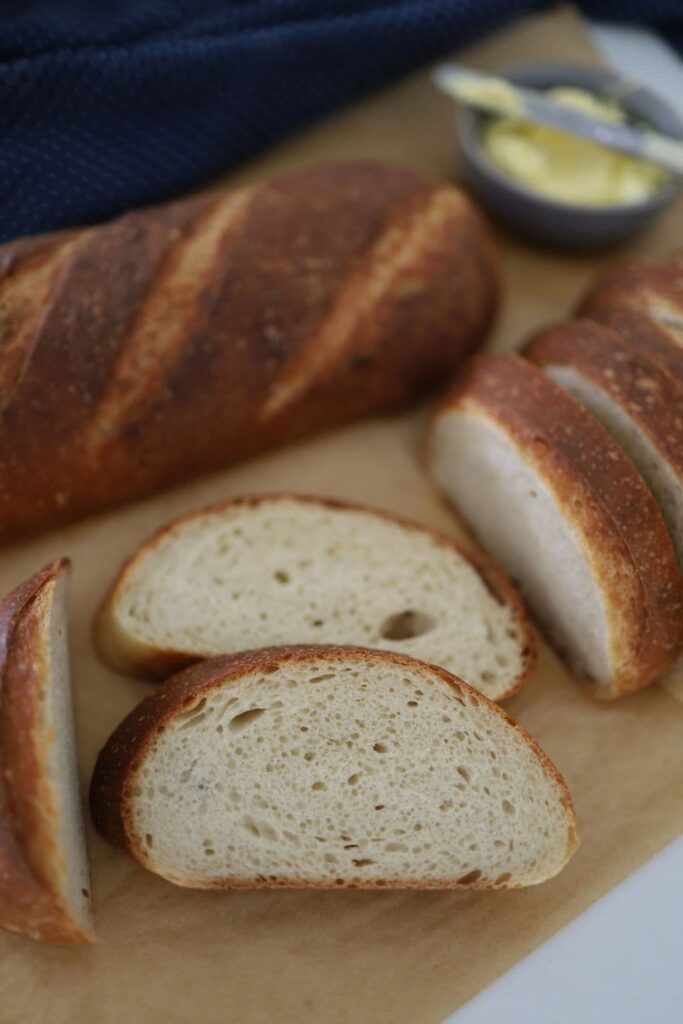
If you love making sourdough bread, make sure you check out this Sourdough Pane Di Casa Loaf, sourdough cibatta rolls, roasted garlic sourdough bread and this perfect sourdough bread made in a Dutch Oven.
Why You'll Love This Sourdough French Bread Recipe
- It's So Easy - this straight forward recipe uses simple ingredients and easy shaping techniques to create a truly delicious loaf of French Bread you'll be proud to share with family and friends (especially spread with this whipped Brie butter).
- No Fancy Equipment - you don't need any fancy equipment to make this loaf of sourdough. A kitchen scale is a much (because we know weighing our ingredients gives us better bread), but other than that, you'll need a bowl and a parchment paper lined baking tray. Too easy!
- It Freezes So Well - this loaf freezes so well! I love having a few of these in the freezer for "bread emergencies". Defrost and warm it up and it's just like having fresh baked bread straight out of the oven!
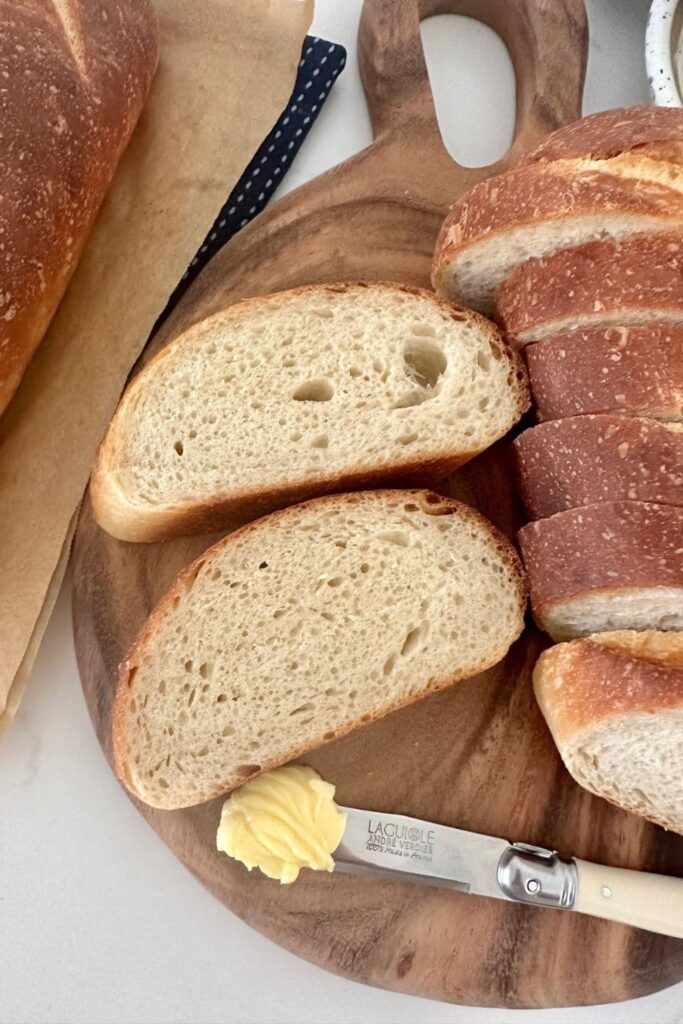
How To Make Sourdough French Bread
This sourdough French bread recipe really is an easy one. The dough is elastic and fairly easy to work with, so it's perfect for beginners. You will need an active sourdough starter that has been fed and is risen and bubbly (but I've got notes on using discard further down). If you don't have a sourdough starter, you'll find instructions for making a sourdough starter here.
Shaping this sourdough French Bread is super simple, you literally just need to roll the dough up into a log! That's why it's such a great sourdough recipe if you're just getting started, or shaping isn't your favorite thing.
So let's bake some Sourdough French Bread!
- Add the sourdough starter, sugar, olive oil and warm water to a large mixing bowl. Stir together to break up the sourdough starter and dissolve the sugar (the oil will not mix and that's ok).
- Now add the bread flour and salt and bring together into a shaggy dough. Cover the dough with a damp towel or plastic food cover and allow it to sit for around one hour.
- Now, tip the dough onto a clean surface and knead it until it is smooth and elastic. This dough will be slightly sticky but try not to add too much flour or your dough will become dry and this will affect your sourdough French bread when it's baked.
Try to knead it for around 5 to 10 minutes by hand. It's a really easy dough to work with, and the more you knead it, the silkier it will get.
You can do this step in a stand mixer on low speed (using a dough hook) or a Thermomix using the knead function if you'd prefer. - Once the dough is sufficiently kneaded, place it back into the bowl and cover. Allow it to sit until it has risen around 30 to 50%. You don't want it to double for this recipe or it will be too difficult to shape.
- When the dough is ready, tip it onto a clean surface and divide it in half using a bench scraper (I've made two loaves but you can just make one large one if you'd prefer).
- Pull the dough into a rough square and gently roll it into a log. Pinch the ends and use a dough scraper to transfer to a parchment-lined baking sheet (see I told you it was an easy shaping technique).
- Cover your shaped sourdough French Bread with a damp towel and place in a warm spot to rise. You want the dough to double in size now and become super puffy.
- When you are ready to bake your Sourdough French Bread, preheat your oven to 220C (428F). Ideally you should introduce some steam into your oven to get a true French crust on your bread. You can do this a few different ways (I have added notes at the bottom of the recipe card to give you some methods for this).
- Slash your French Bread with a razor blade or sharp knife (you can see how I've done this in the step by step photos below). You want to slash more vertical than horizontal.
- Carefully place the slashed bread in the oven and bake for around 25 to 30 minutes (removing the steam for the last 10 minutes of the bake to allow the crust to get crunchy).
- Remove the bread from the oven when it's baked (check that it sounds hollow to ensure it's done). Allow it cool on a wire rack.
- For an extra shine on your loaf, brush with butter when it first comes out of the oven. This is completely optional.
Step-by-Step Photo Guide
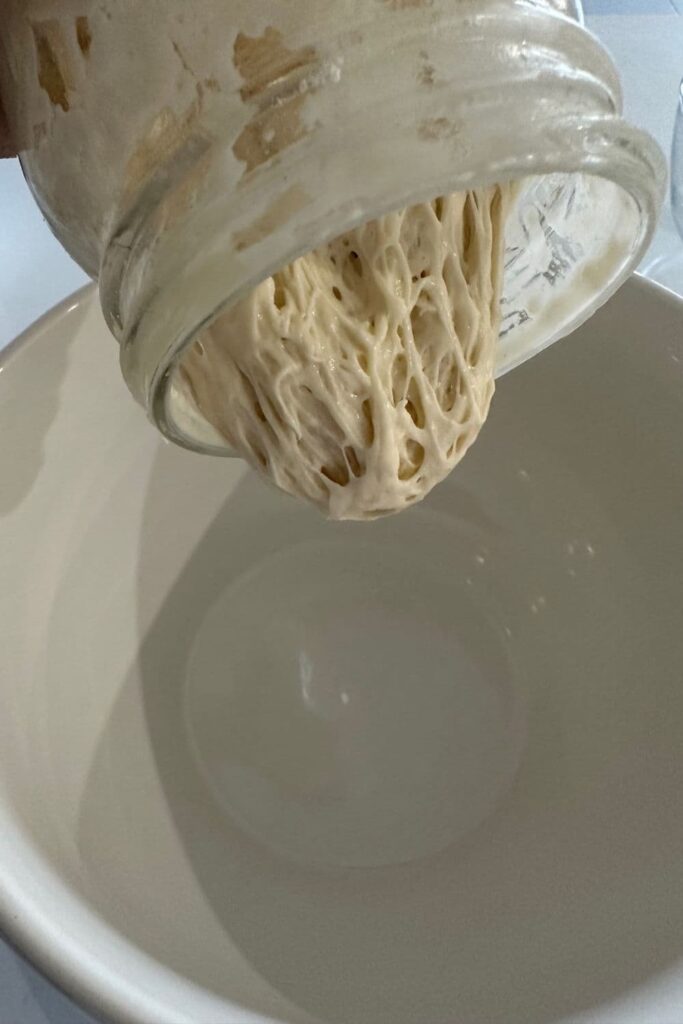
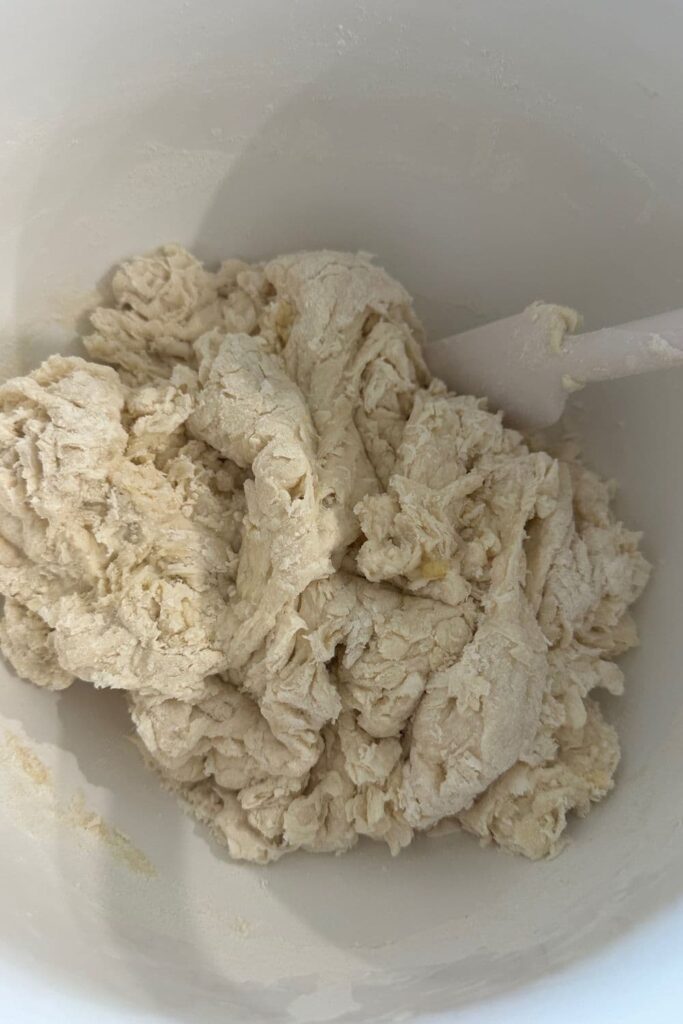
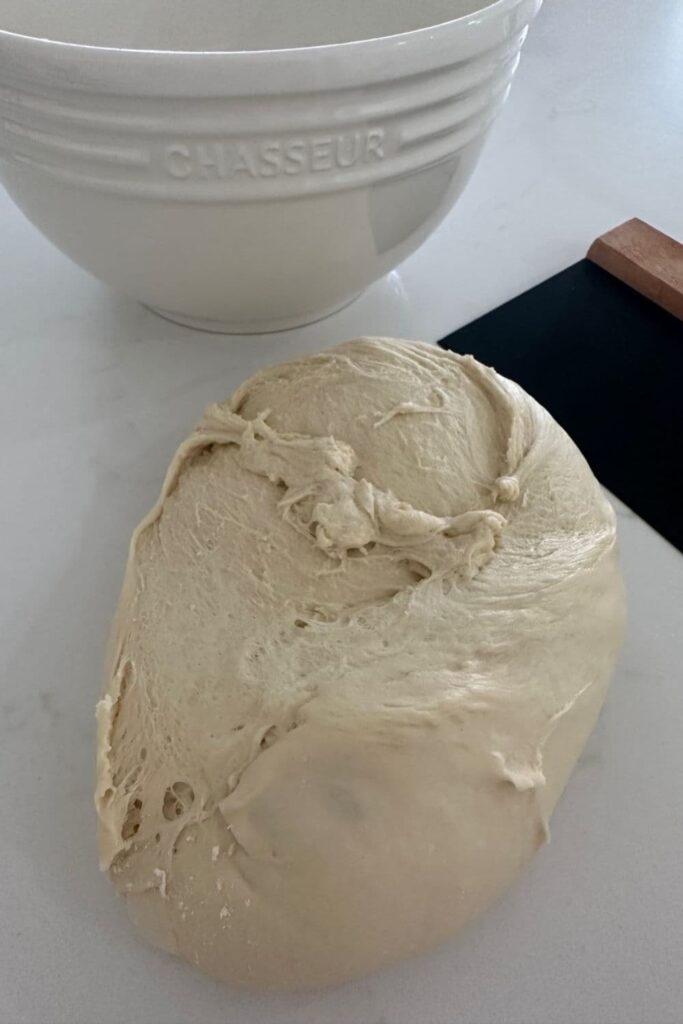
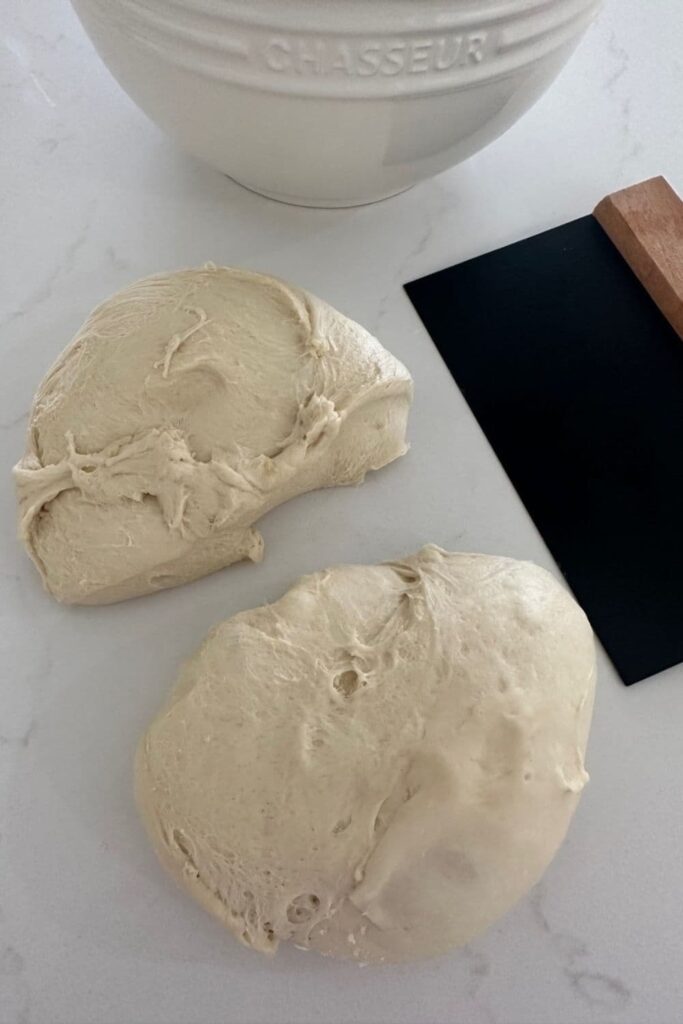
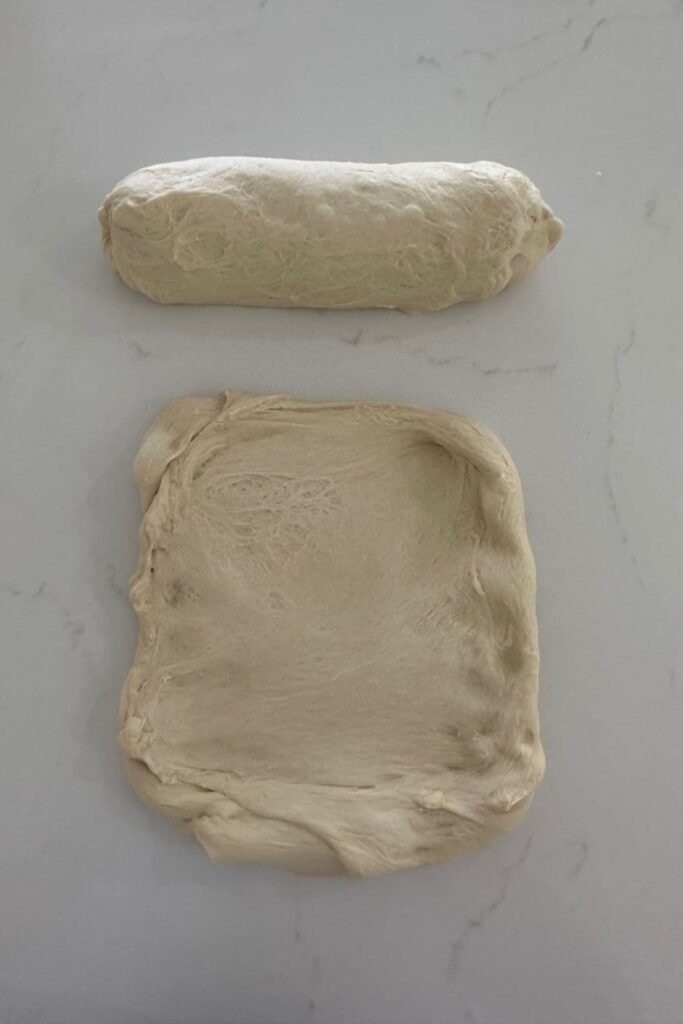

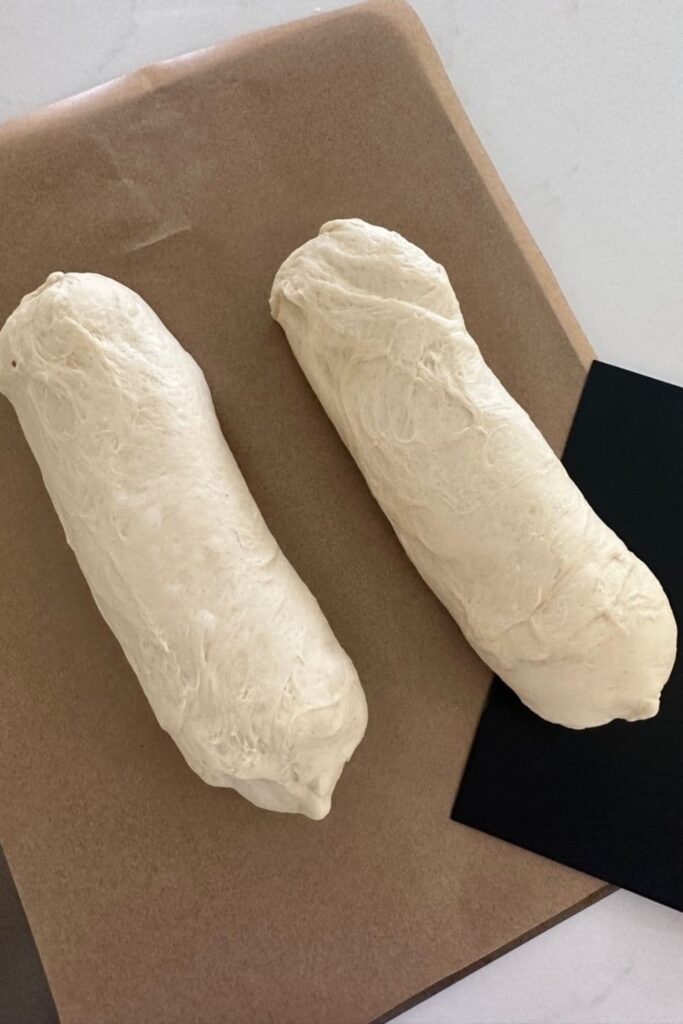
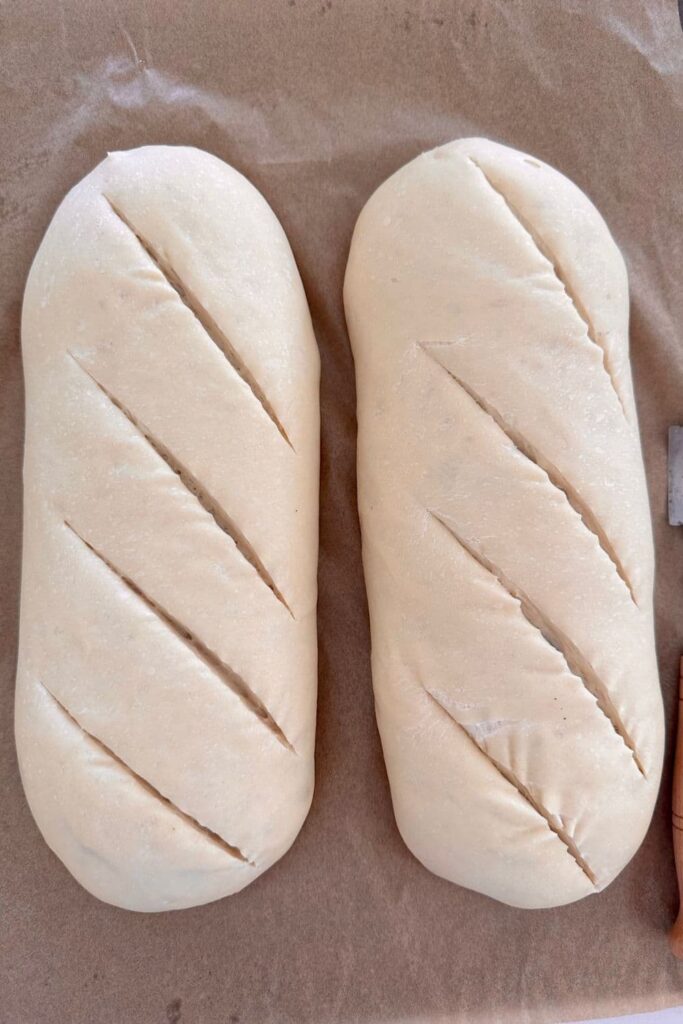
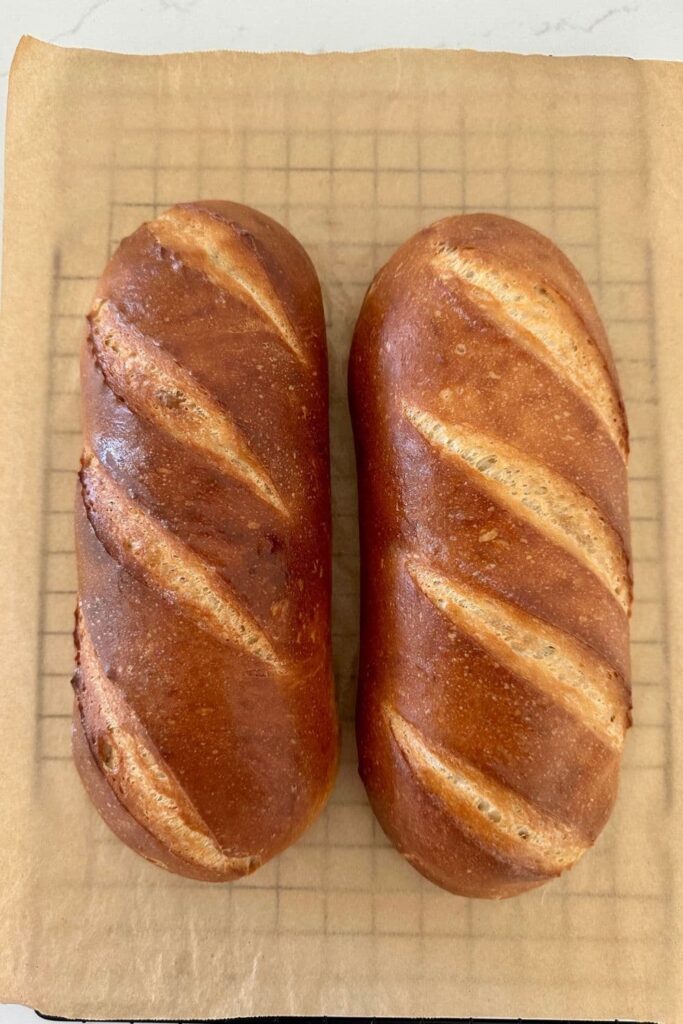
Tips for Baking Sourdough French Bread with Steam
Ideally you should introduce some steam into your oven to ensure you get a chewy but crispy crust (like all good French Bread). There are a number of ways you can do this:
- add an oven safe dish filled with water to the lower rack of your oven. Do this around half way through preheat so that it's sufficiently steamy when you add your bread dough. Remove any excess water after 15 minutes (please be very careful doing this and use high heat resistant gloves).
- throw 4 or 5 ice cubes into the bottom of your oven when you add the bread. Quickly close the door so that the steam is trapped inside as the ice melts.
- You can also find some ideas for adding steam in this post about baking sourdough bread without a Dutch Oven.
The bread in these photos has been baked in a steam oven. My oven has a reservoir that allows me to add water when I turn the oven on. This creates a steamy environment to bake my bread.
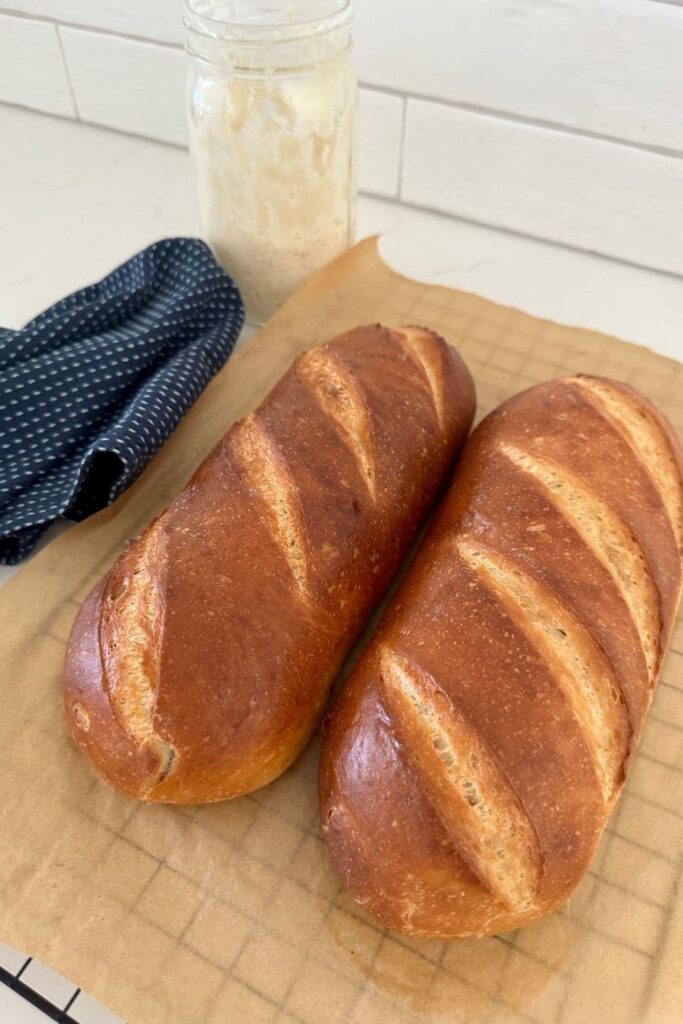
Baker's Timeline for Sourdough French Bread
This is the rough timeline I use when making sourdough French Bread. You could adapt this timeline to suit your own situation. You might also find this article on creating a sourdough baking timeline helpful in adapting it.
Remember, you need to read your dough, not the clock when it comes to sourdough, so my timeline may be too short or too long for your bread.
The Night Before
10pm - Feed sourdough starter so it's bubbly and ready for work tomorrow morning.
The Next Morning
7am - Mix the dough, knead and allow to rise a little in the bowl
12pm - Shape the French bread, cover and leave to proof in a warm place
6pm - Bake the bread!
How To Use Sourdough Discard
If you'd prefer to use sourdough discard instead of active sourdough starter in this recipe, you can just swap it out. You will more than likely need to add some yeast to ensure that your bread rises (unless you have a very old starter and your discard is from a starter fed within 24 hours).
Add 2-3g instant or dried yeast for a slower rise and more flavor. Add up to 7g for a fast rise (but you won't get the same flavor).
Turn This French Bread into Sandwich Bread
I love baking this sourdough French Bread as a sandwich loaf. I use the whole dough (I don't split it into two pieces). I roll it up (just like I would for the regular loaf) and pop it into a buttered sandwich loaf tin. It's incredibly soft and makes the most delicious sandwiches.
I bake this one at 200C (392F) for 40 minutes in a sandwich loaf or pullman pan. The pan I have used for the loaf in the photo is 270mm (L) x 110mm (W) x 110mm (H) and can hold 2.8 litres.
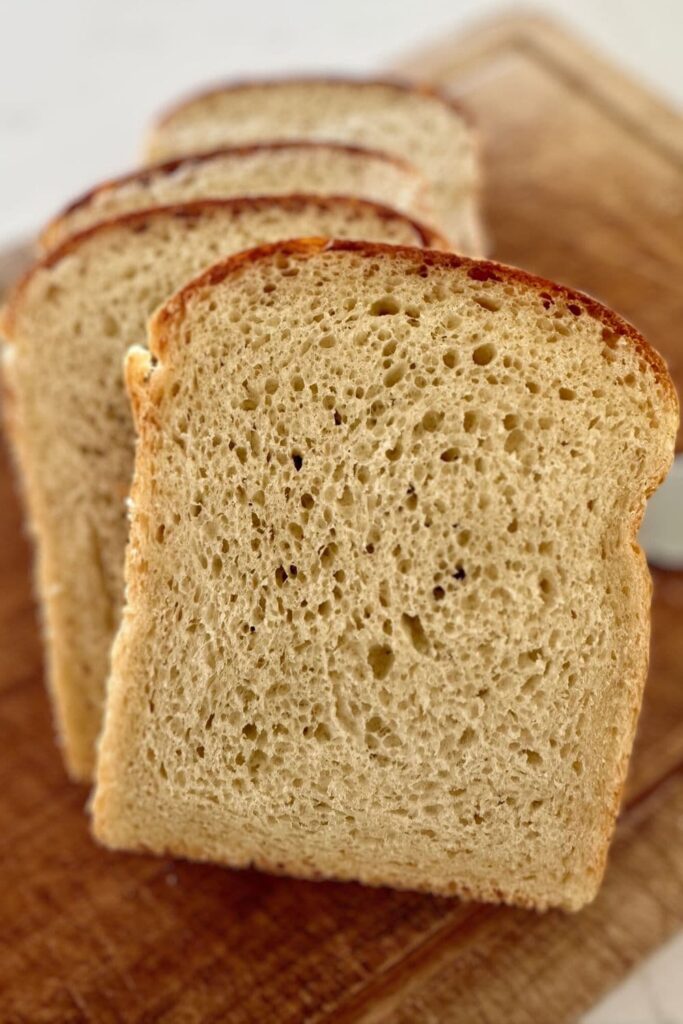
Keeping It Fresh
This loaf is best eaten within 12 hours of being baked. Like all homemade bread (sourdough included), having no preservatives means that it won't stay fresh like store bought bread. Once baked, wrap in a cotton cloth or store in a bread bag until you're ready to slice and eat.
How To Freeze & Refresh
This Sourdough French Bread freezes really well. I love having a few loaves in the freezer to pull out if friends drop in or we are having a quick and easy soup for dinner.
To freeze, simply wrap the whole, cooled loaf in parchment paper and then aluminium foil. Place the loaf in a zip loc bag and store in the freezer for up to 6 months.
To use the frozen loaf, allow it to thaw at room temp then unwrap completely. Spray with a little water mist and place into a hot oven (around 230C (446F) and allow it bake for around 5 - 10 minutes or until the crust is hot and crispy. You can slice it hot out of the oven when you refresh it.
Too easy!

Frequently Asked Questions
I don't recommend using all purpose flour for this loaf. You'll get a better result from using bread flour due to it's higher protein content. If you want to use all purpose flour, try adding some vital wheat gluten to ensure you get a crunchier crust and chewy, but soft interior.
The sugar in this loaf contributes to the golden, crunchy crust and soft spongy interior. If you don't want to add sugar, I suggest using the same amount of honey to still give you some natural sugars in your dough.
Traditionally, French bread is leavened with commercial yeast and sourdough is leavened with wild yeast or sourdough starter. This sourdough French Bread recipe uses sourdough starter to leaven the dough but it is flavored and shaped in a traditional French way to give it that look and feel.
Sourdough is referred to as "Pain de Campagne" which translates to "country bread" or "country loaf".
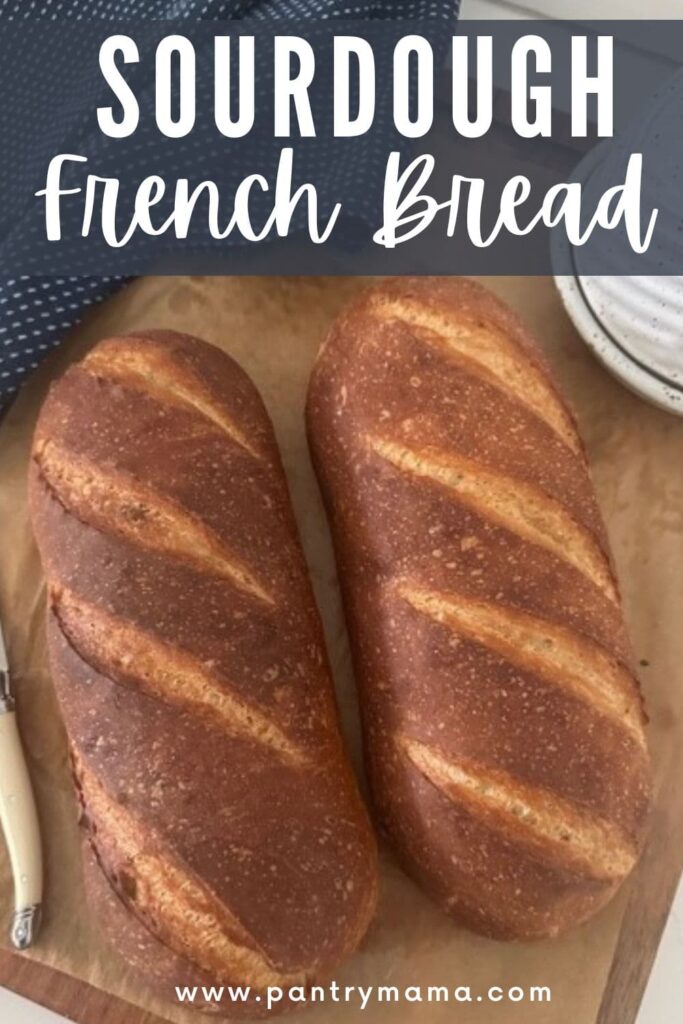
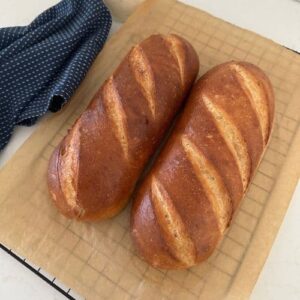
Sourdough French Bread
Video
Ingredients
- 100 g Sourdough Starter (fed and bubbly - see notes)
- 280 g Water
- 30 g Granulated Sugar
- 80 g Olive Oil
- 500 g Bread Flour
- 10 g Salt
Instructions
- Add the sourdough starter, sugar, olive oil and warm water to a large mixing bowl. Stir together to break up the sourdough starter and dissolve the sugar (the oil will not mix and that's ok).
- Now add the bread flour and salt and bring together into a shaggy dough. Cover the dough with a damp towel or plastic food cover and allow it to sit for around one hour.
- Now, tip the dough onto a clean surface and knead it until it is smooth and elastic. This dough will be slightly sticky but try not to add too much flour or your dough will become dry and this will affect your sourdough French bread when it's baked. Try to knead it for around 5 to 10 minutes by hand. You can do this step in a stand mixer on low speed (using a dough hook) or a Thermomix using the knead function.
- Once the dough is sufficiently kneaded, place it back into the bowl and cover. Allow it to sit until it has risen around 30 to 50%. You don't want it to double for this recipe or it will be too difficult to shape.
- When the dough is ready, tip it onto a clean surface and divide it in half using a bench scraper.
- Pull the dough into a rough square and gently roll it into a log. Pinch the ends and use a dough scraper to transfer to a baking sheet lined with parchment paper.
- Cover your shaped sourdough French Bread with a damp towel and place in a warm spot to rise. You want the dough to double in size now and become super puffy.
- When you are ready to bake your Sourdough French Bread, preheat your oven to 220C (428F). Ideally you should introduce some steam into your oven to get a true French crust on your bread. You can do this a few different ways (I have added notes at the bottom of the recipe card to give you some methods for this).
- Bake your French Bread for around 25 to 30 minutes (removing the steam for the last 10 minutes of the bake to allow the crust to get crunchy).
- Remove the bread from the oven when it's baked (check that it sounds hollow to ensure it's done). Allow it cool on a wire rack.
- For an extra shine on your loaf, brush with butter when it first comes out of the oven. This is completely optional.
Notes
- add an oven safe dish filled with water to the lower rack of your oven. Do this around half way through preheat so that it's sufficiently steamy when you add your bread dough. Remove any excess water after 15 minutes (please be very careful doing this and use high heat resistant gloves).
- throw 4 or 5 ice cubes into the bottom of your oven when you add the bread. Quickly close the door so that the steam is trapped inside as the ice melts.
- You can also find some ideas for adding steam in this post about baking sourdough bread without a Dutch Oven.
Nutrition


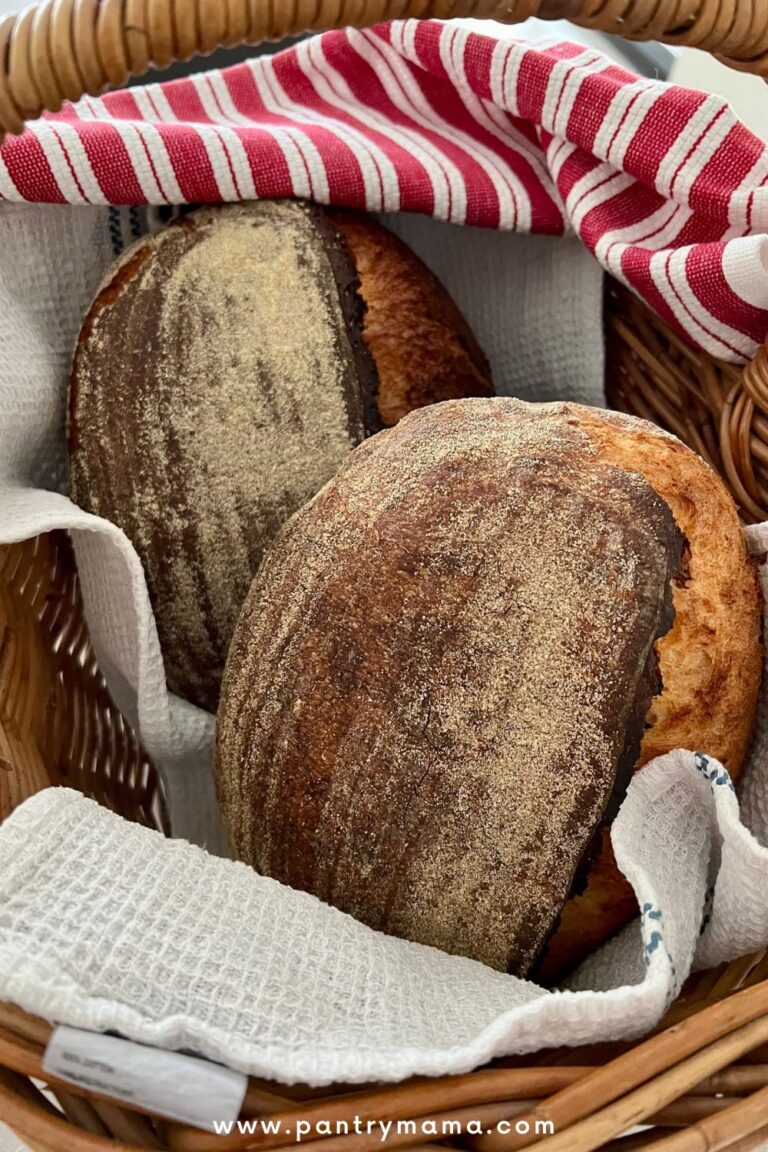
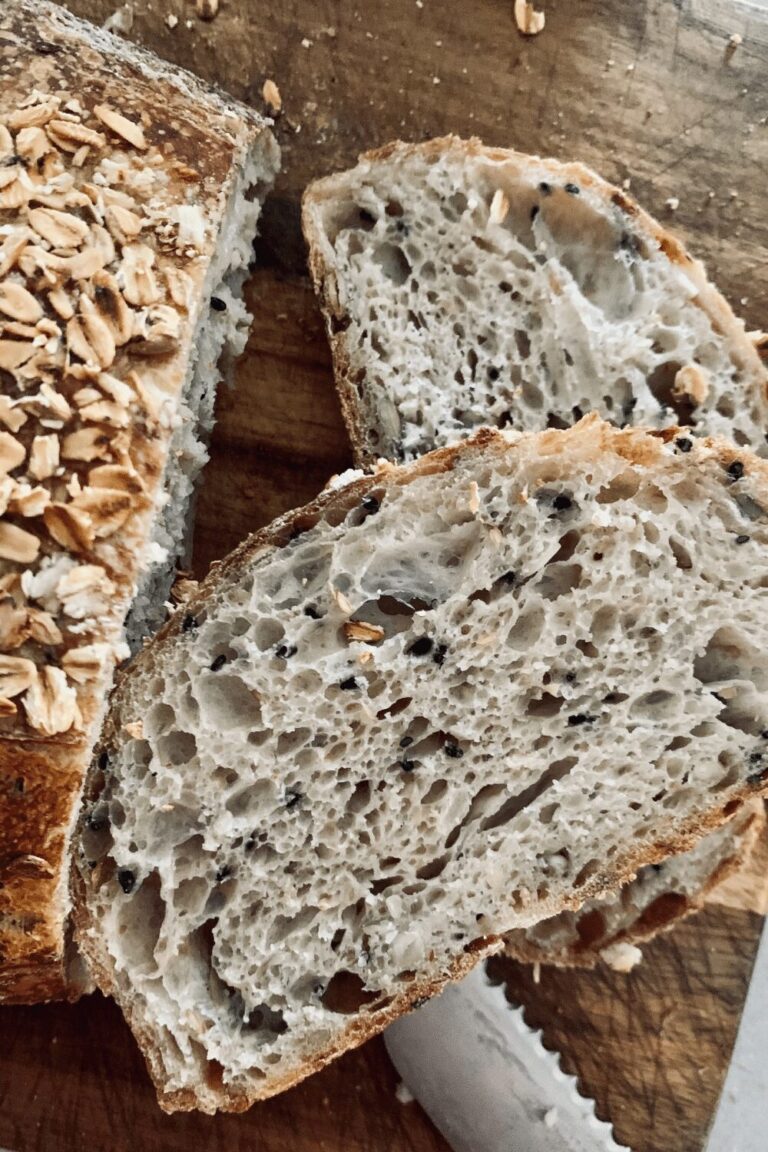
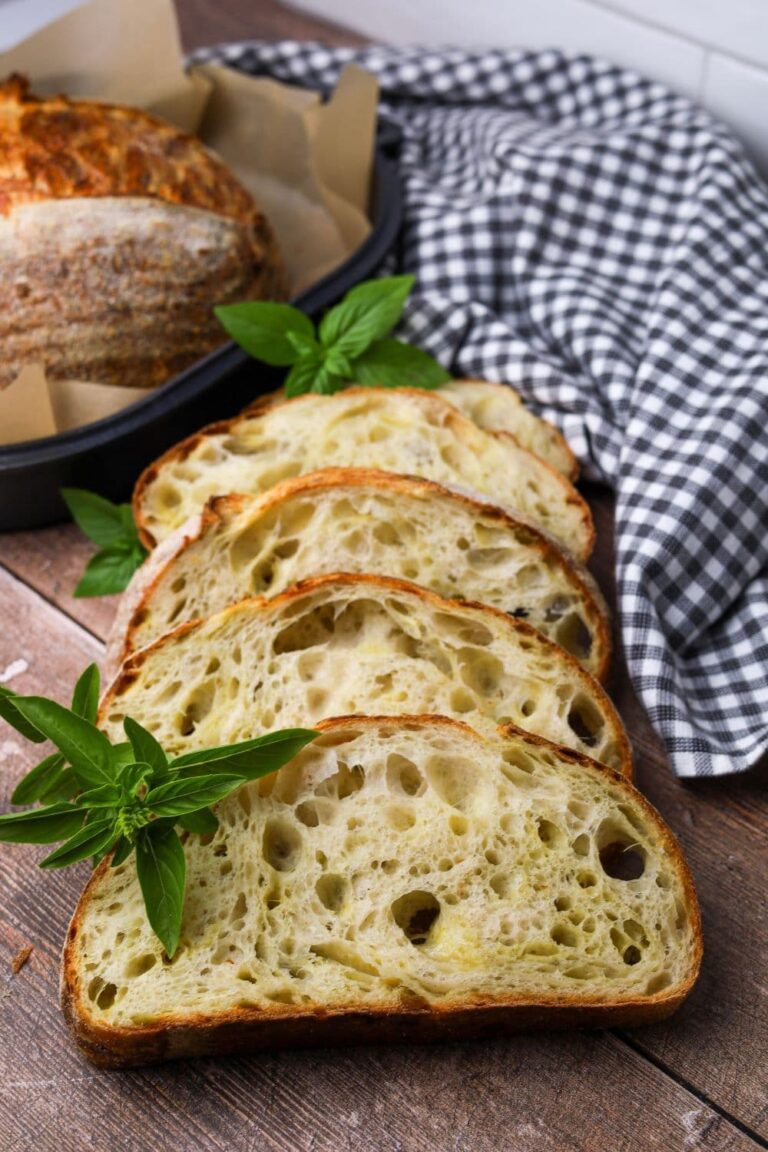


Thus recipe was easy and turned out very well. I'm not a fan of the olive oil in it so next time I'll use regular oil.
My dough came out very soft and sticky- I don't know if I should add more flour or not . Please help
I love this bread. I baked it in my Challenger Bread pan with ice cubes and cover for first half of bake.
What is the approximate time in a 70degree kitchen it takes for this dough to rise 30%
Thanks!
This bread is the softest sourdough I have ever made ! Soooo good!!!
Delicious recipe! Thank you for sharing.
Making this now, excited to try this french bread. I am experienced with sourdough. It would be very useful if you would give an APPROXIMATE rise time for step 4 and 7 so we can plan accordingly. Your total time says 13 hours, is this what others have found ?
Made some for dinner and it was amazing😋
Did try it and followed this recipe.
But the dough turned out way to wet and sticky could do nothing with it.
Used a good flower brand but didnt helped.
Such a waste!
Sorry to hear that, Ton. Sometimes the dough takes a little longer to knead to get the right texture.
I have enjoyed all your discard recipes I have tried. The Gingerbread was very tasty and soft crumb. I used a combination of Date Syrup for the sulfered molasses. I did use half Black strap molasses which worked and had no bad taste. I made the yellow cake which was very good also. The Pie Crust was my favorite for an apple pie. Tender and tasty. I am trying all. Next will be the muffins. I have a lot to learn about the bread. I tried the French bread today. I followed the recipe to the letter. Not sure why the crumb was so closed and moist. After cooling I did slice and toast some slices. I will make again and hope for better results. I hope to learn from all the experienced members of the group. Thanks for accepting my membership.
Can i bake this bread in a dutch?
Yes you can bake it in a Dutch Oven 🙂
Because I was making 6 loaves of this for an a occasion, I used about 1/3 of a packet of CY in addition to my very active starter to enhance the rise. They all turned out beautifully with that rich sourdough aroma & flavor. Thank you for the recipe!